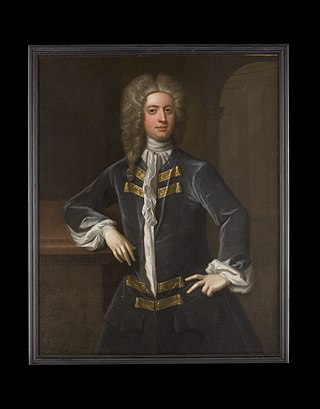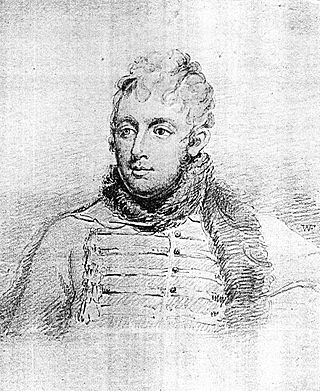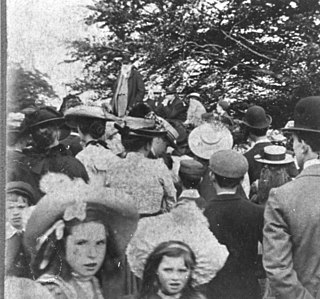Sir Wilfrid Lawson, 1st Baronet, of Isel Hall, Cumberland (c. 1610–1688) was an English landowner and politician who sat in the House of Commons from 1660 to 1679.
Contents

Sir Wilfrid Lawson, 1st Baronet, of Isel Hall, Cumberland (c. 1610–1688) was an English landowner and politician who sat in the House of Commons from 1660 to 1679.

Lawson was born in 1610, the son of William Lawson, and his wife Judith Bewley, daughter of William Bewley of Hesket. His great uncle was Sir Wilfred Lawson who acquired the family estate of Isel in Elizabethan times and served as MP for Cumberland. Lawson matriculated at Queen's College, Oxford on 21 November 1628, aged 17. He was knighted by Charles I on 28 February 1641. [1]
Although knighted by Charles I in 1641, and appointed to the position of ship money sheriff and a nominee to the commission of array, Lawson became active on parliaments behalf at the start of the English Civil War. He set up a garrison on St Herbert's Island, Derwent Water, then part of his estate, [2] and became commander-in-chief for Cumberland in 1644. He held local office throughout the Interregnum, and sat for the county in Richard Cromwell’s Parliament. But his loyalty to the Rump was suspect, and he was imprisoned. [3]
In 1643, he attempted to seize Carlisle Castle for the Parliament; however, the local gentry and the militia routed the parliamentarians and pursued them to Abbey Holme, only to release them on the understanding that they would discontinue their belligerence. [4]
In 1652, he assisted a group of Cromwell’s supporter’s when they laid waste to Rydal Hall. His acts of aggression also included the persecution of the Quaker community. [5] He became High Sheriff of Cumberland in 1635, 1645–1647, and 1652–1657 and succeeded his father c.1654, inheriting Isel Hall.[ citation needed ]
In 1659, Lawson was elected Member of Parliament (MP) for Cumberland in the Third Protectorate Parliament. He was re-elected MP for Cumberland in 1660 for the Convention Parliament. An inactive Member of the Convention, he was appointed to 11 committees, including the committee of elections and privileges and those for the land purchases and indemnity bills. After the Restoration he was named to the committees to inquire into impropriate rectories and unauthorized Anglican publications.[ citation needed ]
On 7 July, Christopher Clapham introduced a proviso to the indemnity bill requiring Lawson to make reparations to Sir Jordan Crosland and his wife for the plunder of Rydal Hall. Lawson, in his only recorded speech, 'made his defence, saying he never saw any plate or moneys', which plea the House accepted.[ citation needed ]

At the general election of 1661, Lawson transferred to a borough seat at Cockermouth, where he enjoyed a strong burgage interest until 1679. However, he proved to be one of the least active Members of the Cavalier Parliament, and apparently veered towards the Court. He left no trace in the Journals till the 1666 session when he was added to the elections committee, and appointed to those to inquire into the charter of the Canary Company and to consider a bill for the relief of poor prisoners. [1]
In 1688, shortly before his death, he purchased a baronetcy patent from James II, at a cost of around £2,000. [6] and purchased Brayton from the Salkeld family.
Lawson died in 1688. He had married Jane Musgrave, sister of Sir Edward Musgrave, 1st Baronet of [Nova Scotia] and had five sons and eight daughters, twelve of whom survived to be married. The following is the epitaph in the chancel of Isel church:
Here lies Sir Wilfrid Lawson, baronet, and his Lady Jane
He departed this life 13th day of December 1688 aged 79
And she the 8th June 1677 aged 65. Having married four
sons and eight daughters. Vivit post funers virtue.
His eldest son, William, married Milcah Strickland daughter of Sir William Strickland, 1st Baronet of Boynton, Yorkshire and had a son Wilfrid and two daughters. But William having previously lost his eyesight died within the lifetime of his father. [7]
Lawson settled the family estate at Isel on his grandson Wilfrid (son of his first son William), who subsequently became Sir Wilfrid Lawson, 2nd Baronet; and to Wilfrid, MP for Cockermouth, his second son, he bequeathed the manors of Brayton, Bassenthwaite, Hensingham and Loweswater so founding the line of ‘Brayton’ Lawson's upon whom the baronetcy descended on the failure of the Isel Lawsons. Wilfrid also predeceased his father, Brayton passing to his son Gilfrid.[ citation needed ]
The Lawsons are descended from John Lawson, who was Lord of Fawkegrave in Yorkshire in 1216, the first year of Henry III. [8] Through a long line of eminent ancestors we arrive at Sir Wilfrid Lawson (1545–1632), son of Thomas Lawson of Ushworth (died 1559). [9] Following the death of Thomas Salkeld of Whitehall, Mealsgate [10] his estates including the building and land known as Brayton, passed to Salkeld's three surviving daughters. On 4 September 1658, Thomas Wyberg Esq., of St Bees, Joseph Patrickson of Howe, and William Barwis of Paddigil signed a deed on behalf of their wives the three co-heiresses, transferring the Brayton Manorial Estates and other property valued at one thousand pounds to Sir Wilfrid Lawson of Isel, the 1st Baronet's great-uncle.

Sir Wilfrid Lawson, 2nd Baronet was an English temperance campaigner and radical, anti-imperialist Liberal Party politician who sat in the House of Commons variously between 1859 and 1906. He was recognised as the leading humourist in the House of Commons.
Wilfrid Lawson may refer to:
There have been six baronetcies created for persons with the surname of Lawson, two in the Baronetage of England and four in the Baronetage of the United Kingdom. Two creations are extant as of 2010.

Sir Wilfrid Lawson, 3rd Baronet, of Brayton was an English Liberal politician who sat in the House of Commons from 1910 to 1916. He was also a keen sportsman who excelled at cricket and steeplechasing.
The sheriff is the oldest secular office under the Crown. Formerly the sheriff was the principal law enforcement officer in the county but over the centuries most of the responsibilities associated with the post have been transferred elsewhere or are now defunct so that its functions are now largely ceremonial. The sheriff changes every April.
The Baronetcy of Dalston of Dalston was created in the Baronetage of England on 15 February 1641 for William Dalston of Dalston Hall, near Carlisle, Cumbria.
Sir Wilfrid Lawson, 2nd Baronet of Isel was an English politician.

Sir Wilfrid Lawson, 3rd Baronet of Isell FRS was a British politician who sat in the House of Commons from 1718 to 1737.
Sir Wilfrid Lawson, 8th Baronet was a British politician. He inherited the title on the death of Sir Alfred Lawson, 7th Baronet, in 1752. He was one of the Lawson Baronets of Isell, Cumberland.

Sir Wilfrid Lawson, 10th Baronet of Isel, MA (Cantab), was a leading Cumberland landowner. He was one of the Lawson Baronets. He was educated at St John's College, Cambridge.

Sir Wilfrid Lawson, 1st Baronet, of Brayton, was an English landowner, businessman and investor in the new industrial age. He was of the Lawson baronets.
Sir Gilfrid Lawson, 6th Baronet (1675–1749), of Brayton Hall, Cumbria, was an English lawyer and Tory politician who sat in the English House of Commons between 1701 and 1705 and in the British House of Commons from 1708 to 1734.
Sir Gilfrid Lawson, 9th Baronet, was one of the Lawson Baronets.

Wilfrid Lawson of Brayton Hall, Cumberland was an English politician who sat in the House of Commons in 1659 and 1660.
Sir Hilton Lawson, 4th Baronet (1895–1959) was the son of Mordaunt Lawson, third son of Sir Wilfrid Lawson, 2nd Baronet, of Brayton. He was educated at Repton School and later the Royal Military College. He served throughout World War I in the Royal Fusiliers where he attained the rank of Major. In 1939 he rejoined the army, went to France with the British Expeditionary Force, taken prisoner at Dunkirk and did not return until 1945. He succeeded his uncle Sir Wilfrid Lawson, 3rd Baronet, of Isell in 1937 and afterwards took up residence at Isel Hall.
Sir Wilfrid Lawson or Lawsone (1545–1632) was an English landowner and politician who sat in the House of Commons at various times between 1593 and 1614.

Isel Hall is an ancient Cumbrian residence that sits on a steep rise on the northern banks of the River Derwent, two miles (3.2 km) south of Bassenthwaite Lake, three miles (4.8 km) east-north-east of Cockermouth, with views over the Lake District fells and Skiddaw. It was once the home of the Lawson family and is a Grade I listed building.

Brayton Hall is a ruined former mansion in Cumbria, England. Once the ancestral seat of the Lawson family, it stood in a large park, with views of the surrounding countryside and the mountains of the Lake District in the background. Located 1.5 miles east by north of the town of Aspatria, and 7 miles south west by west of the market town of Wigton, it was greatly enlarged and rebuilt in 1868. Brayton Hall was practically destroyed by fire in 1918.
Sir Edward Musgrave, 1st Baronet, was one of the Musgrave Baronets of Hayton Castle.

Mary Camilla Lawson, born Mary Camilla Macan, later Lady Lawson, was a British Liberal Party politician.
{{cite book}}: CS1 maint: location missing publisher (link){{cite book}}: CS1 maint: location missing publisher (link){{cite book}}: CS1 maint: location missing publisher (link){{cite book}}: CS1 maint: location missing publisher (link)